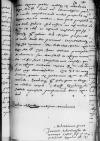 BK, 230, p. 143
BK, 230, p. 143
Reverendissime in Christo praesul et domine, domine colendissime. Salutem cum prospero rerum successu cum felicissimo regimine ac omnis boni incremento Vestrae Reverendissimae Dominationi imprimis adopto ac pariter mea prompta servitia cum me ipsius recommendatione offero.
Nolo Vestram Reverendissimam Dominationem ignorare per manus magnifici domini ⌊palatini Culmensis⌋ sub data praesentium reverendissimi in Christo patris et domini, domini mei colendissimi ⌊episcopi Culmensis⌋ litteras una cum minuta litterarum sacrae ⌊regiae maiestatis⌋ domini, domini nostri clementissimi inclusa advenisse ms. adunsse(!)
⌈advenisseadvenisse ms. adunsse(!)
⌉, qua lecta voluntatem regiam intellexisse maiestatem regiam consuevisse negotia ⌊Prussiae⌋ in praesentia consiliariorum suorum exercere, ubi sua maiestas commemoratur litteris suis propter aetatem suam ac invaletudinem se huc non posse conferre. Ideo ipsos dominos ⌊terrarum Prussiae⌋ consiliarios assistendum se coram eius ⌊maiestate regia⌋ in capite Quadragesimae, etsi non omnes sic saltem e medio sui designandos huius senatus personam repraesentantes lateri suae maiestati assensuros in disceptanda cognoscen  BK, 230, p. 144daque causa cum spectabili ⌊consulatu Gedanensi⌋ adhortari et mandare dignata est. Ad quod quidem consilium meum nimis parvum valetudinarius modo exsistens agnosco, sed quantum virium mihi est pro debito personae meae ⌊regiae maiestati⌋ imprimis demum et patriae videtur non inconsultum votis et mandatis tum et propter conservationem praerogativarum vel iurium, quos ⌊rex Kazimirus⌋ ⌊Prussiae⌋ in causis notabilibus determinandis donavit, tum et amore ⌊Gedanensium⌋ illic, etsi non aperto adiutorio, tamen interdum fidele propter consilium, quod illis partim impartiri potest. Libenter quidem annuerem, ut negotium ad futuram conventionem circa ⌊eius maiestatem⌋ suspendi attentaretur, dummodo id mecum adinvenire possem, qua iusta condicione id circa eius maiestatem obtinere possemus maxime evitando circa eius maiestatem ⌊Gedanensium⌋ partialitatem, propter quam, quomodo prioribus litteris per eius maiestatem tractati sumus, Reverendissima Dominatio Vestra, ut primas ⌊consilii Prussiaci⌋, optime novit. Quare opus esse
BK, 230, p. 144daque causa cum spectabili ⌊consulatu Gedanensi⌋ adhortari et mandare dignata est. Ad quod quidem consilium meum nimis parvum valetudinarius modo exsistens agnosco, sed quantum virium mihi est pro debito personae meae ⌊regiae maiestati⌋ imprimis demum et patriae videtur non inconsultum votis et mandatis tum et propter conservationem praerogativarum vel iurium, quos ⌊rex Kazimirus⌋ ⌊Prussiae⌋ in causis notabilibus determinandis donavit, tum et amore ⌊Gedanensium⌋ illic, etsi non aperto adiutorio, tamen interdum fidele propter consilium, quod illis partim impartiri potest. Libenter quidem annuerem, ut negotium ad futuram conventionem circa ⌊eius maiestatem⌋ suspendi attentaretur, dummodo id mecum adinvenire possem, qua iusta condicione id circa eius maiestatem obtinere possemus maxime evitando circa eius maiestatem ⌊Gedanensium⌋ partialitatem, propter quam, quomodo prioribus litteris per eius maiestatem tractati sumus, Reverendissima Dominatio Vestra, ut primas ⌊consilii Prussiaci⌋, optime novit. Quare opus esse
 BK, 230, p. 145
videtur amore patriae votisque ac mandatis ⌊regiae maiestatis⌋ domini nostri clementissimi parendo, e medio consiliariorum certas personas ad regiam maiestatem mittere, non quod persistam meo tenui iudicio, sed refero me ad melius Reverendissimae Dominationis Vestrae ac aliorum consilium, qui semper hucusque quam optime ⌊terris Prussiae⌋ praefuerunt et modo dante Deo praeerunt. Consultabuntque super his imprimis, ne libertas patriae aut ⌊regiae maiestatis⌋ erga hanc patriam promptitudo clementiae suae maiestatis in aliquo minuatur. Et haec sunt simplicis mei consilii, quae, si in aliquo contraria animo Reverendissimae Dominationis Vestrae sunt, rogo, boni consulere. Cum his me meaque servitia gratiae ac patrocinio Reverendissimae Dominationis Vestrae commendo Eandemque quam felicissime in longaeva valere exopto.
BK, 230, p. 145
videtur amore patriae votisque ac mandatis ⌊regiae maiestatis⌋ domini nostri clementissimi parendo, e medio consiliariorum certas personas ad regiam maiestatem mittere, non quod persistam meo tenui iudicio, sed refero me ad melius Reverendissimae Dominationis Vestrae ac aliorum consilium, qui semper hucusque quam optime ⌊terris Prussiae⌋ praefuerunt et modo dante Deo praeerunt. Consultabuntque super his imprimis, ne libertas patriae aut ⌊regiae maiestatis⌋ erga hanc patriam promptitudo clementiae suae maiestatis in aliquo minuatur. Et haec sunt simplicis mei consilii, quae, si in aliquo contraria animo Reverendissimae Dominationis Vestrae sunt, rogo, boni consulere. Cum his me meaque servitia gratiae ac patrocinio Reverendissimae Dominationis Vestrae commendo Eandemque quam felicissime in longaeva valere exopto.
 BK, 230, p. 144daque causa cum spectabili
BK, 230, p. 144daque causa cum spectabili  BK, 230, p. 145
videtur amore patriae votisque ac mandatis
BK, 230, p. 145
videtur amore patriae votisque ac mandatis 


